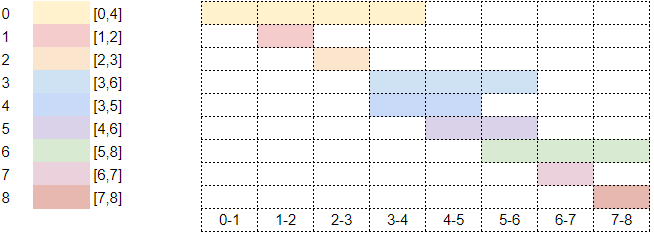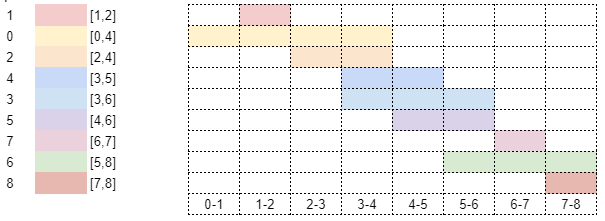Over the course of this chapter, we’ve studied several different
sorting algorithms, learning about their design and implementation, and
analyzing their running time. We mentioned in the introduction of this
chapter that sorting is commonly used as a step in more complex
algorithms, and in this section we’ll introduce one such algorithm to
solve a real-world problem. While the code we’ll develop here will use
the built-in sorted function, we could easily swap it out
with any of the sorting functions we’ve implemented in this chapter.
The problem description
Suppose you are the owner of a restaurant with a private dining room that can be booked by appointment only. Each day, you receive a list of requests to book the room for a certain period of time, and have to decide which requests to approve to book the room. Obviously, you can’t book the room for more than one request at a time, and so can’t say yes to every request if there are conflicting times. Here’s an example of what these requests might look like:

There are many way you could decide which requests to accept. Perhaps you want to maximize the number of requests accepted, or the maximum amount of time that the room is booked for. You might see if you can get additional information, like the number of people expected to use the room or how much they’re willing to bribe you.That’s a joke!!
For the purpose of this section, our goal will be to maximize the number of different requests that we accept. In our above example, we could take requests 1, 2, 3, 7, and 8, giving us 5 non-conflicting booking requests in total. But how do we know that 5 is the maximum number of requests? And more importantly, how can we design an algorithm to compute a schedule for us?
The interval scheduling maximization problem
Our above restaurant example is an instance of a more abstract problem in computer science known as interval scheduling maximization (shortened to interval scheduling).
Interval scheduling maximization problem
Input: a set of tuples, where each tuple is of the form \((b, e)\), where \(b, e \in \R\) and \(b \leq e\). - We call each tuple \((b, e)\) an interval.
Output: the largest possible subset of the input intervals where every pair of intervals are disjoint. We say that two intervals \((b_1, e_1)\) and \((b_2, e_2)\) are disjoint when they don’t overlap except possibly at their endpoints; or equivalently, when \(e_1 \leq b_2\) or \(e_2 \leq b_1\).
- Note: If there is more than one largest possible subset, we can return any of them.
Here is the specification for a Python function to solve this
problem: We’re using ints here to keep things
simple, but the same function will work on floats as
well.
def schedule_intervals(intervals: set[tuple[int, int]]) -> set[tuple[int, int]]:
"""Return a maximum-size subset of intervals that contains only disjoint intervals.
If there is a tie in the maximum size, return any subset of disjoint intervals of that size.
Preconditions:
- all(interval[0] <= interval[1] for interval in intervals)
"""The algorithm
While there are various algorithms for solving the interval scheduling maximization problem, the one we’ll focus on is a algorithm that processes the intervals one at a time, at each iteration choosing whether to select it or not. We say that this algorithm is greedy because it makes choices by processing each interval one at a time, without taking into account what the remaining intervals might be. Here is the skeleton of such an algorithm:
def schedule_intervals(intervals: set[tuple[int, int]]) -> set[tuple[int, int]]:
"""..."""
selected_so_far = set()
for interval in intervals:
if ...:
selected_so_far.add(interval)
return selected_so_farYou might wonder how an algorithm like this could possibly be correct
in computing a subset of maximum size. After all, it wouldn’t be too
hard to fill in the ... with a helper function call that
checks whether the current interval is disjoint with all
current intervals in selected_so_far. But depending on the
iteration order through intervals, we’d get different
subsets, and quite possibly ones of different sizes as well.
It turns out that this algorithm structure does work, as long as we
perform a preprocessing step: sorting the intervals by their end
time. We can achieve this in Python by using the optional
key argument for list.sort. In the code below,
we define an additional function end_time. We also could
have used an anonymous function (with the keyword lambda),
which we will discuss in the next section.
def schedule_intervals(intervals: set[tuple[int, int]]) -> set[tuple[int, int]]:
"""..."""
sorted_intervals = sorted(intervals, key=end_time)
selected_so_far = set()
for interval in sorted_intervals: # Loop over sorted_intervals
if ...:
selected_so_far.add(interval)
return selected_so_far
def end_time(interval: tuple[int, int]) -> int:
"""Return the end time of the given interval."""
return interval[1]Now to complete the implementation, we need to decide when to add a
new interval to our accumulator. The second key insight of this
algorithm is that we can keep track of the latest end time of the
intervals we’ve added so far, and then check whether the current
interval starts after that or not. If it does, then
interval doesn’t conflict with the other intervals in
selected_so_far, and we can add it to the accumulator and
update the latest end time.
Using this idea, here is our complete implementation of
schedule_intervals:
def schedule_intervals(intervals: set[tuple[int, int]]) -> set[tuple[int, int]]:
"""..."""
sorted_intervals = sorted(intervals, key=end_time)
selected_so_far = set()
latest_end_time = -math.inf
for interval in sorted_intervals: # Loop over sorted_intervals
if interval[0] >= latest_end_time:
selected_so_far.add(interval)
latest_end_time = end_time(interval)
return selected_so_far
def end_time(interval: tuple[int, int]) -> int:
"""Return the end time of the given interval."""
return interval[1]Let’s trace through this algorithm on a concrete example. Recall our room booking request example from earlier:

As a first step, our algorithm sorts these intervals by their end
time, producing a list sorted_intervals that looks
like:

Our loop (for interval in sorted_intervals) iterates
through these intervals one at a time.
- At the first iteration,
interval = (1, 2)andlatest_end_time = -math.inf, and so this interval gets added to the accumulator.latest_end_timegets updated to2. - At the second iteration,
interval = (0, 4)andlatest_end_time = 2. But theninterval[0] < latest_end_time, and so it doesn’t get added to the set. - At the third iteration,
interval = (2, 4)andlatest_end_time = 2. Theninterval[0] >= latest_end_time, and so this interval is added to the accumulator.latest_end_timegets updated to4.
This process repeats for every interval; here is the full loop
accumulation table for this
algorithm. Remember, the latest_end_time and
selected_so_far columns show the values of these variables
at the end of the row’s corresponding loop
iteration.
| Iteration | interval |
latest_end_time |
selected_so_far |
|---|---|---|---|
| 0 | -math.inf |
set() |
|
| 1 | (1, 2) |
2 |
{(1, 2)} |
| 2 | (0, 4) |
2 |
{(1, 2)} |
| 3 | (2, 4) |
4 |
{(1, 2), (2, 4)} |
| 4 | (3, 5) |
4 |
{(1, 2), (2, 4)} |
| 5 | (3, 6) |
4 |
{(1, 2), (2, 4)} |
| 6 | (4, 6) |
6 |
{(1, 2), (2, 4), (4, 6)} |
| 7 | (6, 7) |
7 |
{(1, 2), (2, 4), (4, 6), (6, 7)} |
| 8 | (5, 8) |
7 |
{(1, 2), (2, 4), (4, 6), (6, 7)} |
| 9 | (7, 8) |
8 |
{(1, 2), (2, 4), (4, 6), (6, 7), (7, 8)} |
So at the end, we obtain the final set of disjoint intervals
{(1, 2), (2, 4), (4, 6), (6, 7), (7, 8)}. Notice that this
set has the same size as the one we discussed in the opening example,
but is not identical to it. This is a good reminder that there can be
more than one set with the maximum size.

But why does this algorithm work?
It might seem surprising to you that this algorithm works at all,
given how short it seems to be! There are two subtle ideas at play in
this algorithm: the sorting order (why end time?) and how we use the
second accumulator variable latest_end_time to determine
whether interval is disjoint to all of the elements of
selected_so_far.
The latter is the easiest to explain, and we’ll use a familiar
approach: encoding the key property of latest_end_time as a
loop invariant.
def schedule_intervals(intervals: set[tuple[int, int]]) -> set[tuple[int, int]]:
"""..."""
sorted_intervals = sorted(intervals, key=end_time)
selected_so_far = set()
latest_end_time = -math.inf
for interval in sorted_intervals: # Loop over sorted_intervals
# Loop invariant: latest_end_time is the maximum end time of the selected intervals
assert (selected_so_far == set() or
latest_end_time == max(end_time(i) for i in selected_so_far))
if interval[0] >= latest_end_time:
selected_so_far.add(interval)
latest_end_time = end_time(interval)
return selected_so_farSo our variable latest_end_time represents the
maximum end time of the intervals in
selected_so_far. This justifies why we can always just
compare interval[0] >= latest_end_time to determine
whether interval is disjoint to all of the selected
intervals: if interval[0] >= latest_end_time, then
interval[0] is >= all of the
interval end times in selected_sof_far, and so is disjoint
with them. And because we’re iterating through the intervals in order of
end time, we know that we can assign
latest_end_time = end_time(interval) every time we add the
current interval to the selected set.
So that’s how we’re using latest_end_time, and why it’s
helpful to have sorted the intervals based on their end time. But this
doesn’t explain how we know that selected_so_far has
maximum size! And in fact, if we had instead sorted the intervals by
some other “key” functions, like their start time or size, this
algorithm wouldn’t always return an interval set with the maximum
possible size.
Intuitively, it is the maximum end time of the intervals selected so far that determines which of the remaining intervals might conflict or not, rather than the start times or interval lengths. But how do we formalize this intuition? While it is possible to prove that sorting by end time does indeed result in the maximum set size, doing so is beyond the scope of this course.But don’t worry, you’ll discuss interval scheduling and this algorithm formally in CSC373!
For now, you’ll have to take our word for it that this algorithm is indeed correct, and makes use of sorting in a vital way. In fact, if you analyze the running time of this algorithm, the for loop takes \(\Theta(n)\) time (where \(n\) is the number of intervals), so in fact the slowest part of this algorithm is the sorting step, even though the algorithm’s logical complexity lies not in the sorting itself but what we’re sorting by.